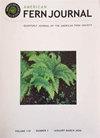Anthropogenic Stone Walls are an Important Habitat for Rare Ferns and Lycophytes in Japan
IF 0.9
4区 生物学
Q4 PLANT SCIENCES
引用次数: 0
Abstract
Abstract. This study aimed to demonstrate that stone walls are habitats for rare ferns and lycophytes in Japan. A survey on 47 Red Data Books (RDBs) published in each prefecture in Japan, revealed the descriptions of 47 fern and lycophyte species (equivalent to 6.5% of all native species of ferns and lycophytes in Japan) designated as near threatened or above in the RDBs and growing on stone walls in Japan. Eleven of these species were listed in the prefectural RDBs as well as in the national RDB of Japan. Overall, 40 species (85.1%) had a preferred original habitat of cliffs or rocky outcrops, and 24 species (51.1%) preferred the forest floor. The high number of identified species that prefer cliffs or rocky outcrops supports the Urban Cliff Hypothesis, which states that man-made structures such as urban buildings and walls serve as alternatives to cliffs, rocky outcrops, or screes as alternative habitat. However, in previous domestic studies that documented fern and lycophyte species growing in established hardscapes in Japan, the most frequently occurring species were mostly weedy or ruderal. As there are few studies on the composition of species growing on stone walls in Japan, more studies must investigate this aspect as well as examining the variation in species composition because of the differences in species pools, climatic conditions, or geological background.人造石墙是日本珍稀蕨类植物和苔藓植物的重要栖息地
摘要这项研究旨在证明石墙是日本稀有蕨类植物和番茄属植物的栖息地。对日本每个县出版的47本红色数据书(RDBs)进行的一项调查显示,在RDBs中,47种蕨类和番茄属植物(相当于日本所有本土蕨类和番茄植物的6.5%)被指定为近危或以上,生长在日本的石墙上。这些物种中有11种被列入了县RDB和日本国家RDB。总体而言,40个物种(85.1%)喜欢悬崖或岩石露头的原始栖息地,24个物种(51.1%)喜欢森林地面。大量已确定的物种喜欢悬崖或岩石露头,这支持了城市悬崖假说,该假说认为,城市建筑和墙壁等人造结构可以替代悬崖、岩石露头或碎石作为替代栖息地。然而,在之前的国内研究中,记录了生长在日本已建立的硬地中的蕨类和石松植物物种,最常见的物种大多是杂草或杂草。由于日本很少有关于石墙上生长的物种组成的研究,因此必须进行更多的研究来调查这一方面,并检查由于物种库、气候条件或地质背景的差异而导致的物种组成变化。
本文章由计算机程序翻译,如有差异,请以英文原文为准。
求助全文
约1分钟内获得全文
求助全文
来源期刊

American Fern Journal
生物-植物科学
CiteScore
1.20
自引率
0.00%
发文量
28
审稿时长
6 months
期刊介绍:
The American Fern Journal is a peer-reviewed journal focused on the biology of ferns and lycophytes.
 求助内容:
求助内容: 应助结果提醒方式:
应助结果提醒方式:


